What are the 4 Social Personality Types?
There are four behavioral-focused Social Personality Types based on your level of Assertiveness and Responsiveness. It’s your personality that’s on display!
In the early 1960s, two industrial psychologists, David Merrill and Roger Reid, wanted to understand whether they could predict managerial, leadership, and sales performance. To do this, they explored how people behaved in social situations and chose not to concern themselves with why.
Merrill and Reid started with BF Skinner’s ideas of behaviorism and James Taylor’s structured list of behavioral descriptions, and they discovered that people’s behavior follows along two continua, which they labeled Assertiveness and Responsiveness.
Assertiveness Style
The Assertiveness Style ranges from asking behaviors to telling behaviors, while the Responsiveness Style varies from emoting or displaying our feelings to controlling our emotions.
Assertive people can initiate, maintain, and terminate conversations skillfully. They are competitive, dominant, forceful, and independent.
Responsiveness Style
Responsive people are others-oriented, meaning they listen to others and show a general concern for their success. They are helpful, compassionate, friendly, sincere, and considerate of others’ feelings.
An individual’s level of Assertiveness and Responsiveness determines their Social Style.

Behavior
Even though human behavior can seem random, you can learn to predict how people will behave in
most situations. They tend to follow patterns of behavior that have become habitual for them.
You will not be able to predict every move, but you will be able to establish probabilities of behavior.
The key to identifying a person’s Social Style is focusing on their behavior– what they say and do.
When you are observing behavior, make sure to avoid the tendency to read meaning into what
you see and hear. Don’t make inferences or judgments.
Merrill and Reid defined four behavioral styles from these two dimensions. As with other models, we have our preferences but can occasionally display all the styles.
The model’s value lies in using it to assess the people around you and knowing how to get the best from people with each preference.
Merrill and Reid referred to a person’s ability to adapt to other people’s styles as versatility.
Assertiveness
Assertiveness is a social skill that relies heavily on effective communication while respecting others’ thoughts and wishes.
Assertive people can clearly and respectfully communicate their wants, needs, positions, and boundaries.
No matter the topic, there’s usually no question about where they stand.
Assertive people don’t shy away from defending their points of view or goals or from trying to influence others to see their side.
They react to positive and negative emotions without becoming aggressive or resorting to passivity and are open to compliments and constructive criticism.
From a cognitive standpoint, assertive people experience fewer anxious thoughts, even under stress.
From a behavioral standpoint, assertive people are firm without being rude.
Assertive Behavioral Patterns
| LESS ASSERTIVE | MORE ASSERTIVE | |
|---|---|---|
| Amount of Talking | Less | More |
| Rate of Speaking | Slower | Faster |
| Voice Volume | Softer | Louder |
| Body Movement | Less, Slower | More, Faster |
| Energy Expressed | Less | More |
| Posture | Leans Back | Leans Forward |
| Forcefulness of Gestures | Less | More |
Here are some characteristics and behaviors of more assertive people.
- Exude more energy and move faster.
- Gesture more vigorously and have more intense eye contact.
- Be erect or lean forward, especially when making a point.
- Speak more rapidly, louder, and more often.
- Address problems quicker.
- Decide quicker and are more risk-oriented.
- Be more confrontational.
- Be more direct and emphatic when expressing opinions, requesting, and giving directions.
- Exert more pressure for a decision or for taking action.
- Demonstrate anger quicker.
Here are some characteristics and behaviors of less assertive people.
- Demonstrate less energy and move more slowly.
- Gesture less vigorously and have less intense eye contact.
- Lean backward even when making a point.
- Speak less rapidly, more softly, and less often.
- Be slower in addressing problems and decide less quickly.
- Be less risk-oriented.
- Be less confrontational.
- Be less direct and emphatic when expressing opinions, requesting, and giving directions.
- Exert less pressure to make a decision or take action.
- Demonstrate anger less quickly.
The Benefits of Being Assertive
One of the main benefits of being assertive is that it can help you become more self-confident as you better understand who you are and the value you offer.
Assertiveness provides several other benefits to help you in your workplace and other areas of your life. In general, assertive people:
Make great managers.
- They get things done by treating people fairly and respectfully and are treated by others similarly.
- This means they are often well-liked and seen as leaders people want to work with.
Negotiate successful “win-win” solutions.
- They change the value of their opponent’s position and quickly find common ground with him.
Are better doers and problem solvers.
- They feel empowered to do whatever it takes to find the best solution to their problems.
Are less anxious and stressed.
- They are self-assured and don’t feel threatened or victimized when things don’t go as planned or expected.
The Risks of Being Assertive
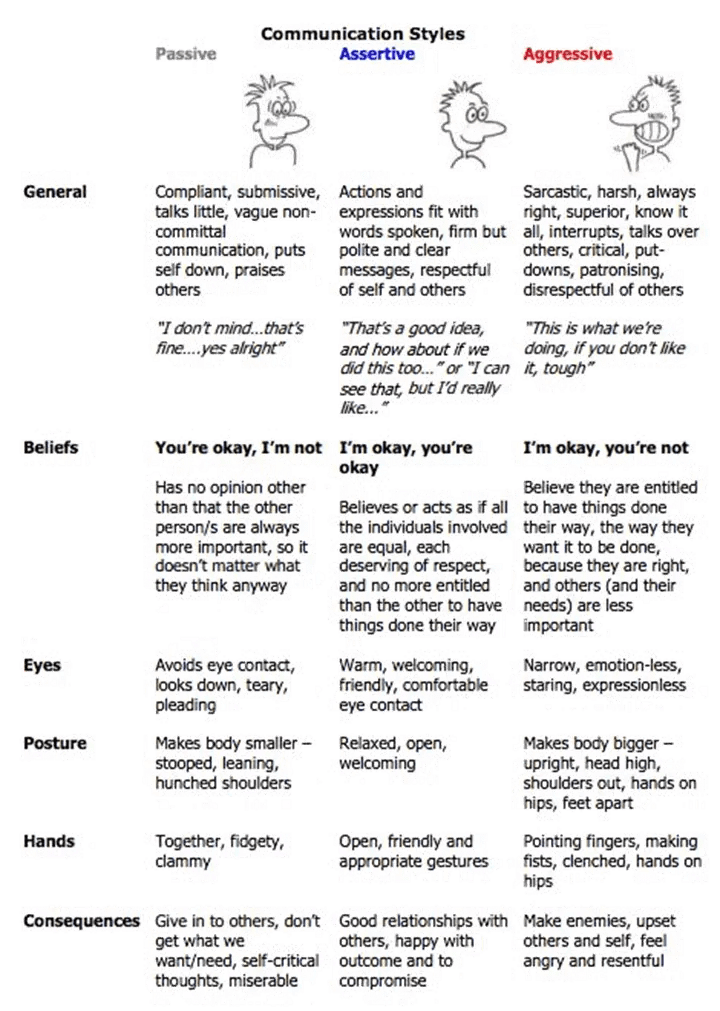
Some organizational and national cultures prefer people to be passive and may view assertive behavior as rude or offensive.
Research has also suggested that gender can affect how healthy behavior is perceived, with men more likely to be rewarded for being powerful than women.
So, it pays to consider the context in which you work before changing your behavior.
However, this doesn’t mean you should succumb to the status quo! Instead, be bold while avoiding naivety.
Experiment with small steps until you find what works for you in your workplace.
Assertive vs. Aggressive Behavior
It’s not always easy to identify truly assertive behavior because there’s a fine line between Assertiveness and Aggression. Unfortunately, people can often confuse the two.
For this reason, it’s helpful to define the two behaviors so that we can separate them:
Assertiveness is about balance.
- It requires being forthright about your wants and needs while still considering the rights, conditions, and desires of others.
- When assertive, you are self-assured and draw power from this to express your point firmly, somewhat, and empathetically.
Aggressive behavior is about winning.
- You do what is in your best interest without regard for other people’s rights, needs, feelings, or desires.
- When you’re aggressive, the power you use is selfish.
- As a result, you may come across as pushy or even bullying.
- You take what you want, often without asking.
If your Style is aggressive, you may come across as a bully who disregards the needs, feelings, and opinions of others. On the other hand, you may appear self-righteous or superior.
Very aggressive people humiliate and intimidate others and may even be physically threatening.
You may think it is unpleasant, but it gets you what you want. However, it comes at a cost.
Aggression undercuts trust and mutual respect. As a result, others may resent you, leading them to avoid or oppose you.
Assertive vs. Passive-Aggressive Behavior
If you communicate in a passive-aggressive manner, you may say yes when you want to say no.
You may be sarcastic or complain about others behind their backs.
Rather than confront an issue directly, you may show your anger and feelings through your actions or negative attitude.
You may have developed a passive-aggressive style because you’re uncomfortable being direct about your needs and feelings.
What are the drawbacks of a passive-aggressive communication style?
Over time, passive-aggressive behavior damages relationships and undermines mutual respect, making it difficult to meet one’s goals and needs.
How to be more Assertive
Here are some tips to help you become more assertive:
Assess your Style.
- Do you voice your opinions or remain silent?
- Do you say yes to additional work even when your plate is full?
- Are you quick to judge or blame?
- Do people dread or fear talking to you?
- Understand your Style before you begin making changes.
Use ‘I’ statements.
- Using “I” statements lets others know what you think or feel without sounding accusatory.
- For instance, say, “I disagree,” rather than, “You’re wrong.”
- If you have a request, say, “I would like you to help with this,” rather than “You need to do this.”
- Keep your requests simple and specific.
Practice saying no.
- If you have difficulty turning down requests, try saying, “No, I can’t do that now.”
- Don’t hesitate — be direct.
- If an explanation is appropriate, keep it brief.
Rehearse what you want to say.
- If it’s challenging to say what you want or think, practice typical scenarios you encounter.
- Say what you want to say.
- It may also help to write it out first so you can practice from a script.
- Consider role-playing with a friend or colleague and ask for direct feedback.
Use body language.
- Communication isn’t just verbal.
- Act confident even if you aren’t feeling it.
- Keep an upright posture, but lean forward a bit.
- Make regular eye contact. Maintain a neutral or positive facial expression.
- Don’t cross your arms or legs. Instead, practice assertive body language in front of a mirror or with a friend or colleague.
Keep emotions in check.
- Conflict is challenging for most people.
- Maybe you get angry or frustrated, or perhaps you feel like crying.
- Although these feelings are normal, they can get in the way of resolving conflict.
- If you feel too emotional going into a situation, wait a bit, if possible.
- Then, work on remaining calm. Breathe slowly. Keep your voice even and firm.
Start small.
- First, practice your new skills in low-risk situations.
- For instance, try your Assertiveness on a partner or friend before tackling a difficult situation at work.
- Evaluate yourself afterward and tweak your approach as necessary.
Responsiveness
Responsiveness is how you are perceived to express feelings when communicating with others.
Task-oriented, responsive people tend to prefer to focus communications on tasks.
Relationship-oriented, responsive people prefer to focus on the people working on the task.
Responsive Behavioral Patterns
| LESS RESPONSIVE | MORE RESPONSIVE | |
|---|---|---|
| How much facial animation? | Less | More |
| How much voice variation? | Less | More |
| How are their gestures flowing? | Less | More |
Here are some characteristics and behaviors of more responsive people.
- Express feelings more openly.
- Appear friendlier.
- Be more facially expressive.
- Gesture more freely.
- Have more vocal inflection.
- Be comfortable with small talk.
- Use more anecdotes and stories.
- Express more concern about the human aspect of issues.
- They prefer working with people.
- Dress more casually.
- Be less structured in their use of time.
Here are some characteristics and behaviors of less responsive people.
- Be less disclosing of feelings.
- Appear more reserved.
- Have less facial expressiveness.
- Gesture less often.
- Have less vocal inflection.
- Be less interested in and less adept at “small talk.”
- Use more facts and logic than anecdotes.
- Be more task-oriented.
- They prefer working alone.
- Dress more formally.
- Be more structured in their use of time.
High Responsiveness
A person with more Responsiveness has a higher emotional response to others, which may appear to be empathy.
However, they may have less control over their emotions and react emotionally.
People with high Responsiveness are generally people-oriented, whether for the company or altruism.
Low Responsiveness
A person with lower Responsiveness is less likely to be empathetic because their reactions are less emotional.
Their response has a higher cognitive element, so they think more before responding, making responses slower.
There are four basic core styles based on the levels of both Assertiveness and Responsiveness.
The Analytical Personality Type
- They are Low in Responsiveness and Assertiveness.
- They are considered to be Technical Specialists.
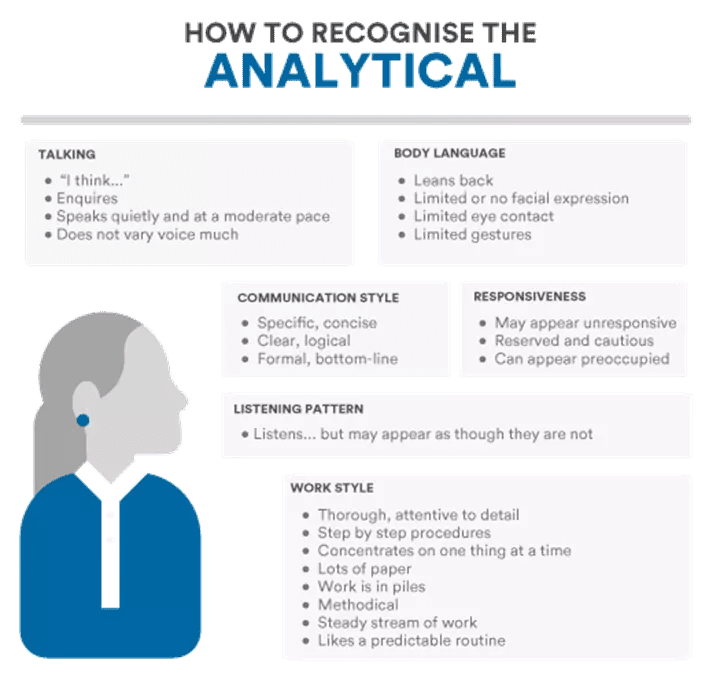
Analytical Personality Type cross-reference
- Keirsey Type – Guardians
- Temperament Type – Melancholy
- Animal Type – Beaver
- DISC Type – Compliant
- True Colors – Gold
- Color Code – White
- Personality Compass – East
- Occupational Type – Realistic
- Learning Type – Pragmatist
- Leadership Type – Avoider
Analytical MBTI Personality Types (xSxJ) – Sensing and Judging
Learn more about the Analytical Social Personality Type.
The Driving Personality Type
- They are Low in Responsiveness and High in Assertiveness.
- They are considered to be Control Specialists.
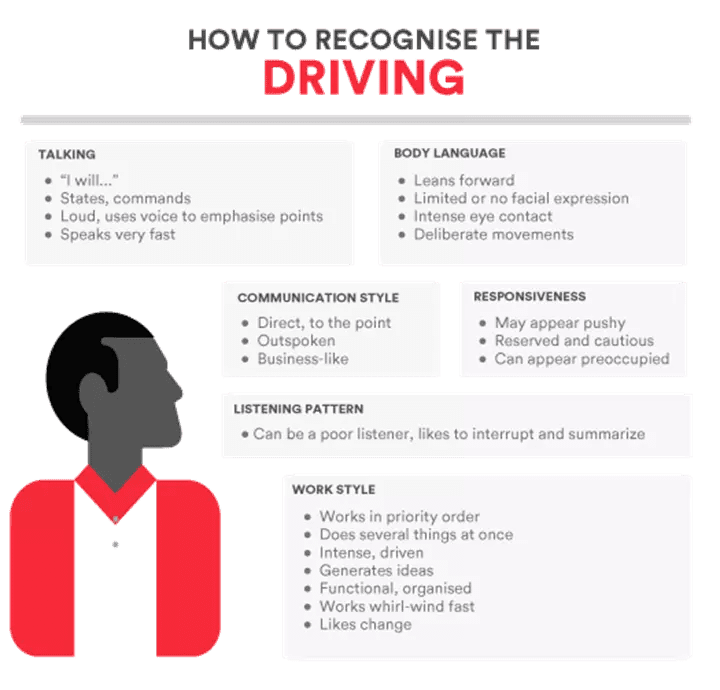
Driver Personality Type Cross-reference
- Keirsey Type – Rationals
- Temperament Type – Choleric
- Animal Type – Lion
- DISC Type – Dominant
- True Colors – Green
- Color Code – Red
- Personality Compass – North
- Occupational Type – Enterprising
- Learning Type – Activist
- Leadership Type – Dominator
Driver MBTI Personality Types (xNTx) – Intuition and Thinking
Learn more about the Driving Social Personality Type.
The Amiable Personality Type
- They are High in Responsiveness and Low in Assertiveness.
- They are considered to be Relationship Specialists.
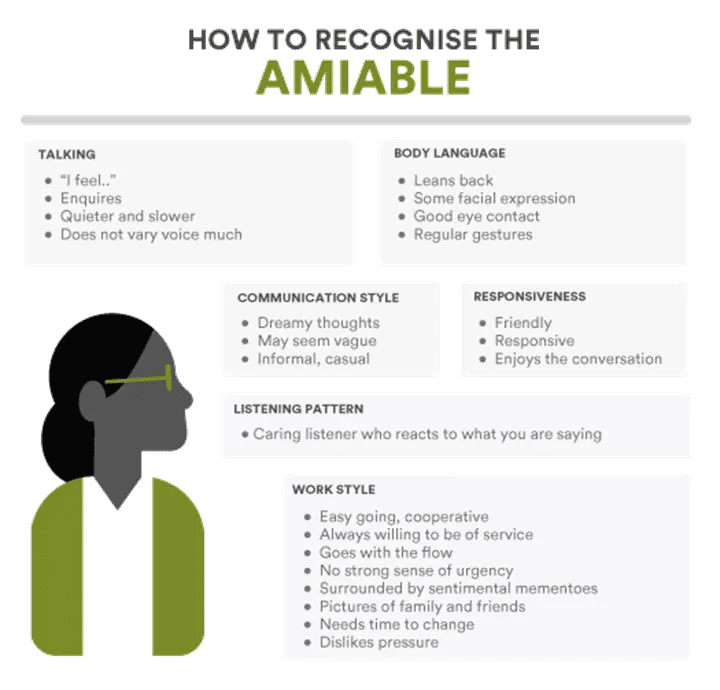
Amiable Personality Type cross-reference
- Keirsey Type – Artisan
- Temperament Type – Sanguine
- Animal Type – Golden Retriever
- DISC Type – Steadiness
- True Colors – Orange
- Color Code – Yellow
- Personality Compass – South
- Occupational Type – Conventional
- Learning Type – Reflector
- Leadership Type – Accommodator
Amiable MBTI Personality Types (xSxP) – Sensing and Perceiving
Learn more about the Amiable Social Personality Type.
The Expressive Personality Type
- They are High in Responsiveness and Assertiveness.
- They are considered to be Social Specialists.
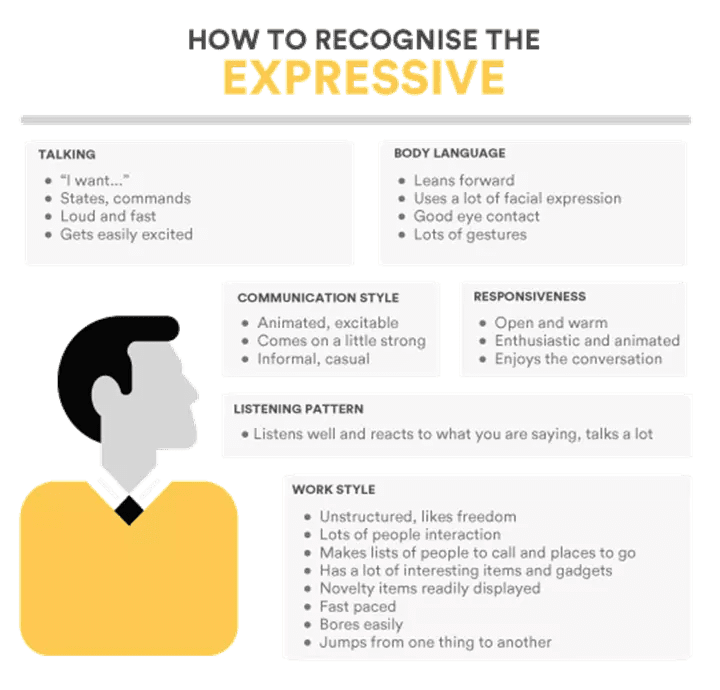
Expressive Personality Type Cross-reference
- Keirsey Type – Idealists
- Temperament Type – Phlegmatic
- Animal Type – Otter
- DISC Type – Influential
- True Colors – Blue
- Color Code – Blue
- Personality Compass – West
- Occupational Type – Artistic
- Learning Type – Theorist
- Leadership Type – Collaborator

